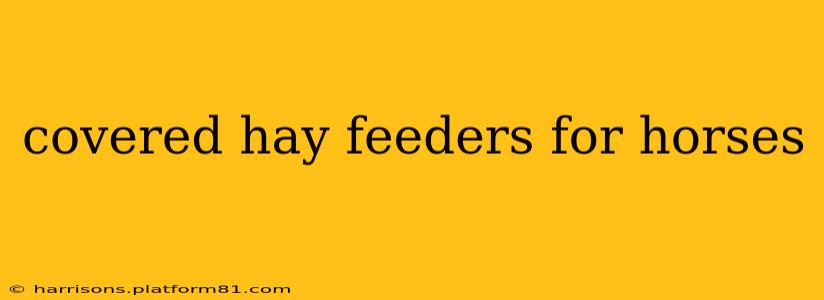Choosing the right hay feeder for your horse is crucial for their health, comfort, and overall well-being. Covered hay feeders offer several advantages over uncovered options, primarily by reducing waste and protecting the hay from the elements. This comprehensive guide will explore the various types of covered hay feeders, their benefits, and how to choose the best one for your equine companion.
What are the benefits of using a covered hay feeder for horses?
Covered hay feeders offer a multitude of benefits compared to simply placing hay on the ground or in an open trough. These include:
- Reduced Hay Waste: A significant amount of hay is wasted when left exposed to the elements or trampled by horses. Covered feeders significantly minimize this waste, saving you money in the long run.
- Protection from Weather: Rain, snow, and excessive sun can damage hay, making it less palatable and even causing mold growth. A covered feeder keeps the hay dry and clean, ensuring your horse consumes nutritious feed.
- Improved Hygiene: Covered feeders help keep hay cleaner and prevent contamination from dirt, dust, and insects. This contributes to better gut health for your horse.
- Slow Feeding: Many covered feeders are designed to slow down a horse's eating pace, preventing them from gulping down hay, which can lead to digestive issues like colic.
- Reduced Spoilage: By protecting hay from the elements and preventing contamination, covered feeders help to prolong the lifespan of your hay supply.
What are the different types of covered hay feeders for horses?
There are various types of covered hay feeders available, each with its own unique features and benefits:
- Slow Feed Hay Nets: These are popular for their ability to significantly slow down feeding and reduce the risk of colic. They come in various sizes and mesh sizes, allowing you to adjust the feeding rate according to your horse's needs.
- Hay Bags: Similar to hay nets, hay bags also slow down feeding, but often offer more protection from the elements due to their enclosed design. They typically have a larger capacity than nets.
- Round Bale Feeders: Designed for round bales, these feeders typically have a roof to protect the hay and often include a slow-feed mechanism to control consumption.
- Square Bale Feeders: Similar to round bale feeders, but built to accommodate square or rectangular bales. They usually offer a protected feeding area and often incorporate features to reduce waste.
- Combination Feeders: Some feeders combine features from multiple designs, such as a slow-feed net within a covered structure.
What size covered hay feeder should I choose for my horse?
The size of the hay feeder you need will depend on several factors:
- Horse's Size and Breed: Larger horses will naturally need larger feeders to accommodate their consumption.
- Hay Type: Different types of hay have varying densities, influencing how much space is needed for a given amount of feed.
- Feeding Frequency: If you plan to refill the feeder multiple times a day, a smaller feeder might suffice. For less frequent refills, a larger capacity is necessary.
How do I choose the right material for a covered hay feeder?
The material of your hay feeder should be durable, weather-resistant, and safe for your horse. Common materials include:
- Metal: Often galvanized steel, offering strength and longevity but potentially prone to rust.
- Plastic: Durable and lightweight, but may not be as robust as metal.
- Wood: Provides a natural look but requires more maintenance and is susceptible to rot if not treated properly.
Where should I place a covered hay feeder for my horse?
The placement of your hay feeder is important for both the horse's safety and the feeder's longevity. Consider the following:
- Level Ground: Ensure the feeder is placed on level ground to prevent tipping.
- Accessibility: The feeder should be easily accessible to your horse but not in a location where it could pose a hazard.
- Drainage: Choose a location with good drainage to prevent water accumulation around the feeder.
- Shelter: If possible, place the feeder in a sheltered area to provide additional protection from the elements.
How often should I clean a covered hay feeder?
Regular cleaning is essential to maintain hygiene and prevent the buildup of mold and bacteria. Aim to clean your covered hay feeder at least once a week, removing any leftover hay, debris, and manure. Thorough cleaning should be more frequent depending on environmental conditions and the type of feeder used.
This comprehensive guide provides a thorough overview of covered hay feeders for horses. Remember to prioritize the safety and well-being of your horse when selecting and using this essential piece of equine equipment. Choosing the right feeder contributes significantly to their overall health and happiness.
